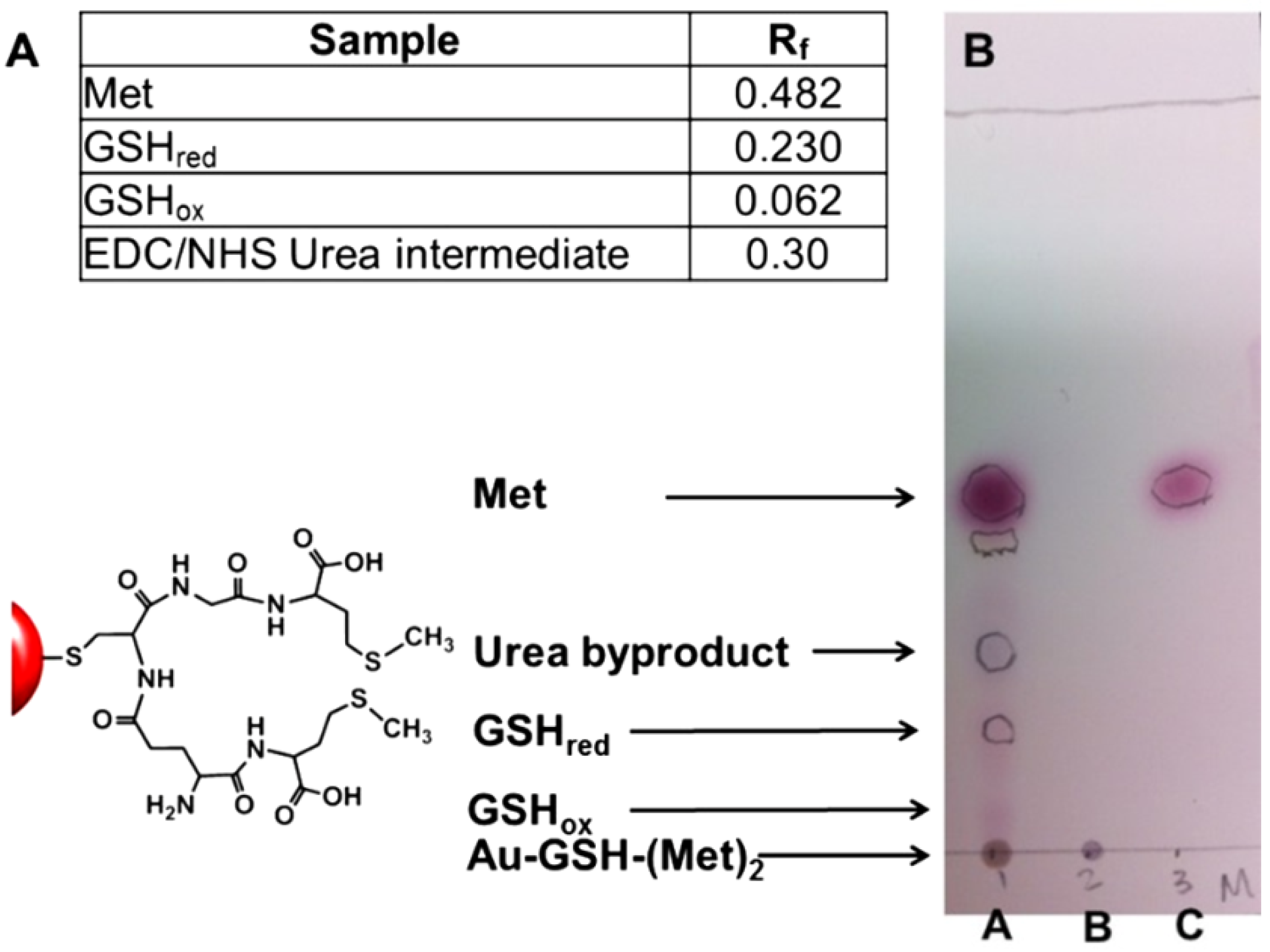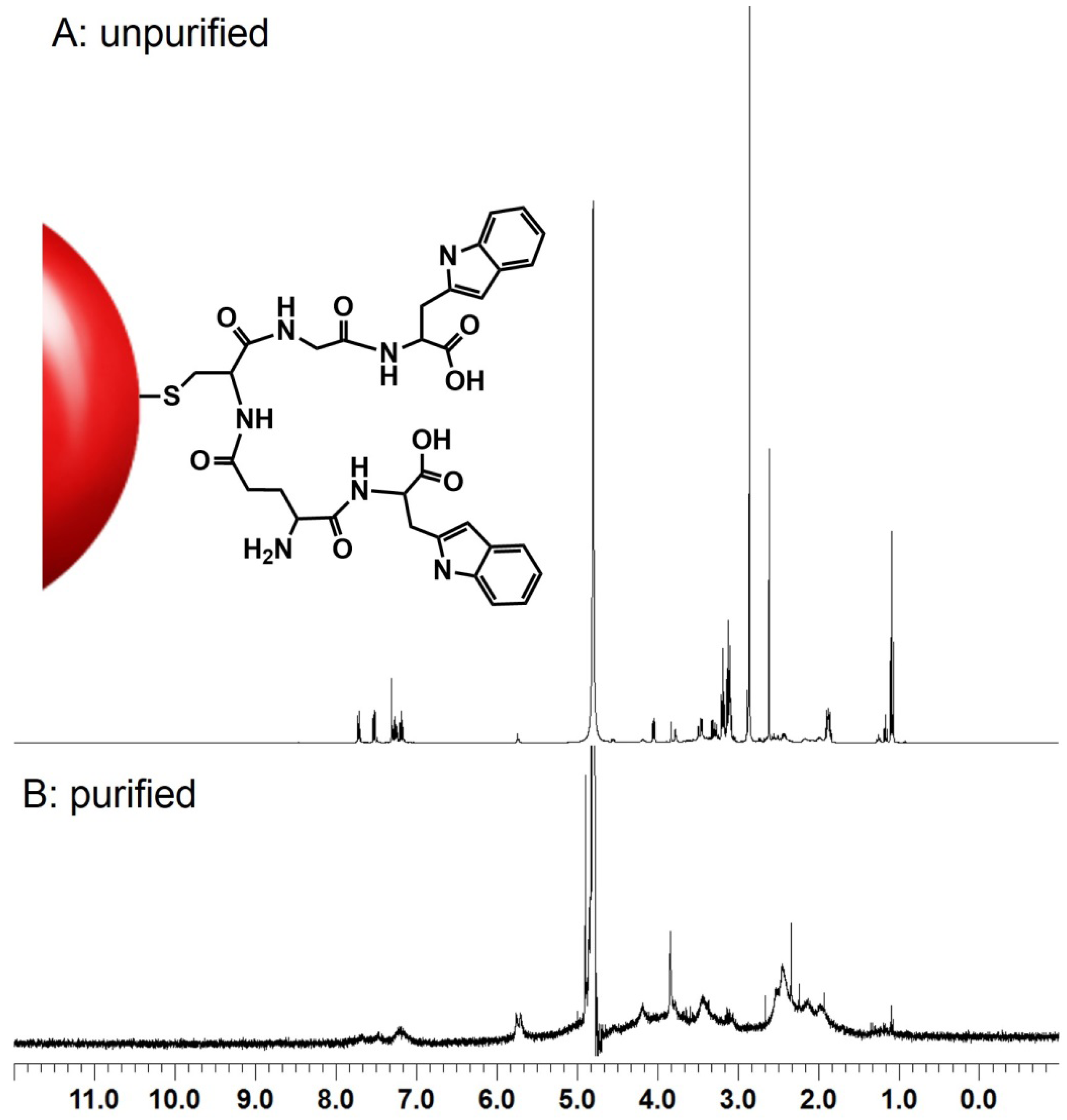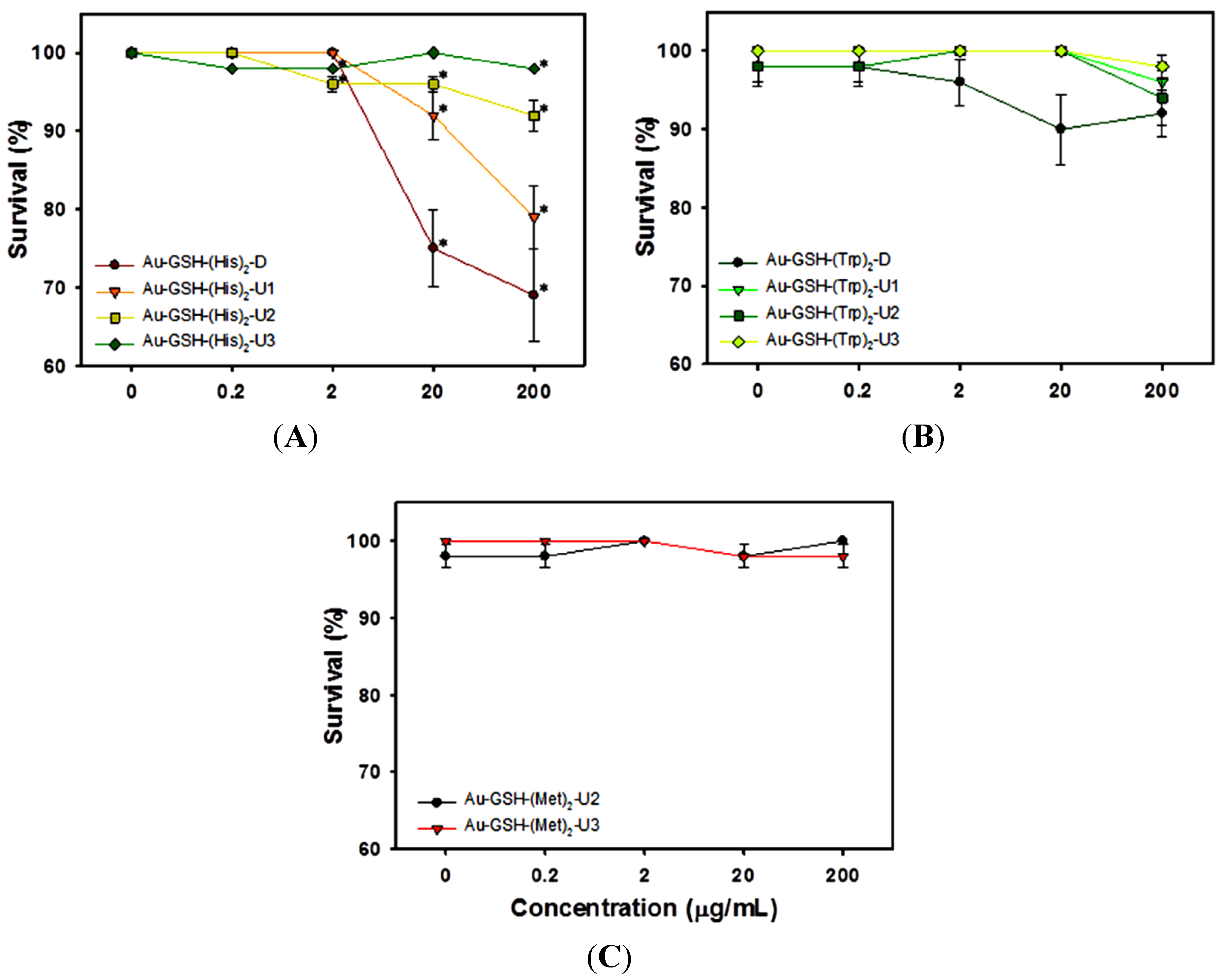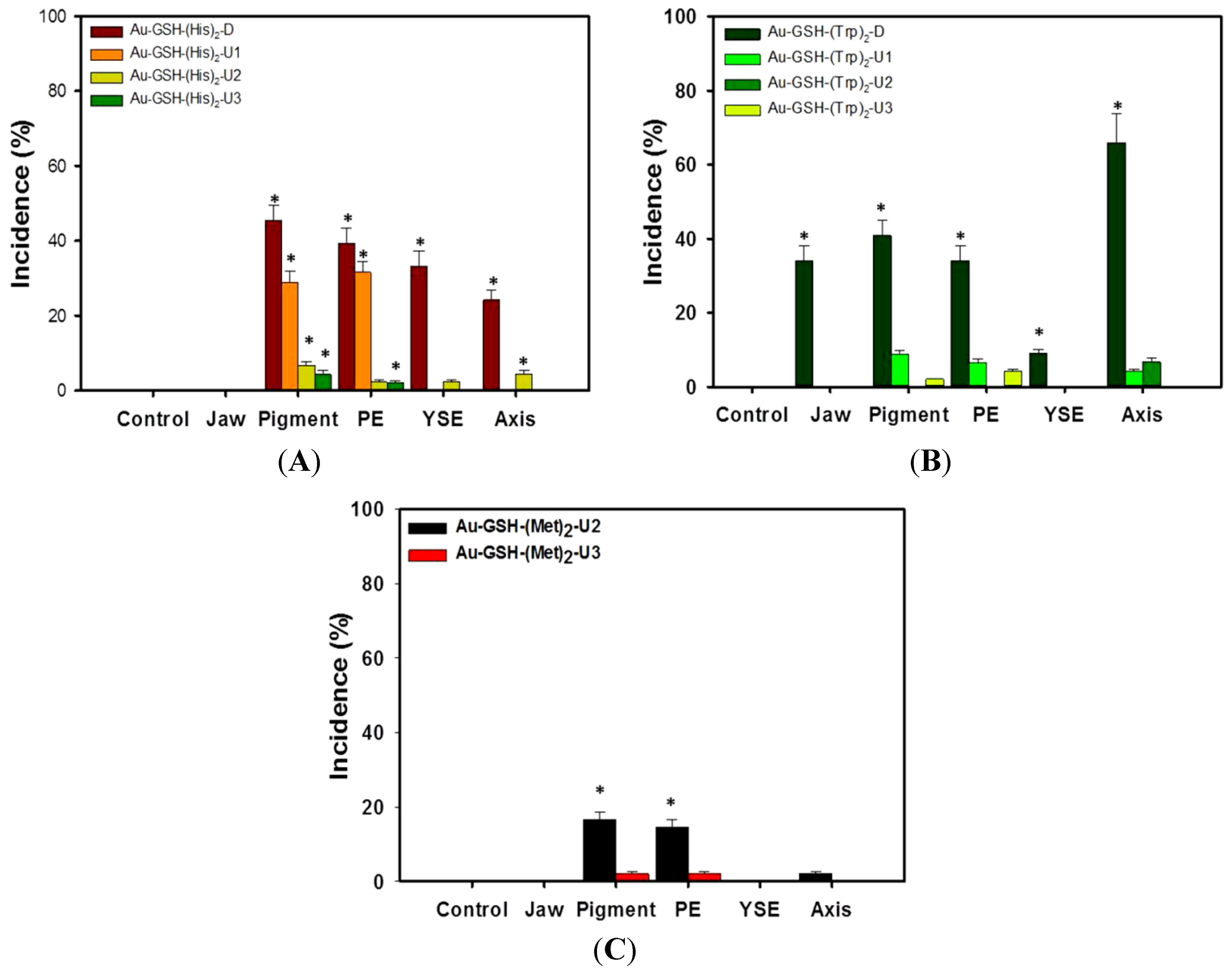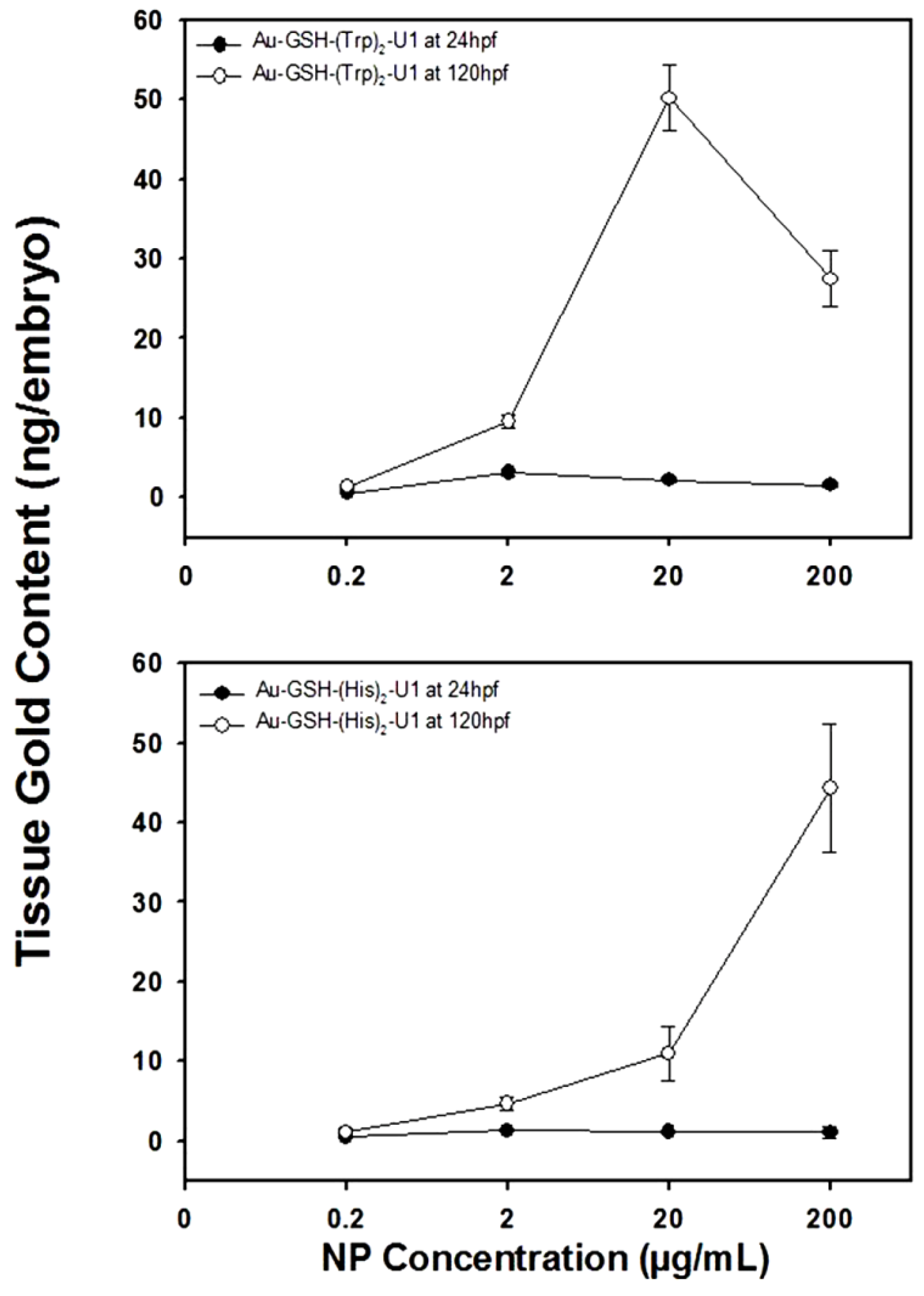The results of these studies show that synthesis and purification methods, as well as surface ligands, impact the overall structure and biocompatibility of Au-GSH NPs. High purity, biocompatible amino acid functionalized Au-GSH NPs can be produced when ultracentrifugation is used as a purification technique at each stage of a multi-step synthesis. The advantages of applying such techniques before and after the addition of each ligand in a multi-step synthesis include: (i) removing impurities from NP suspensions; (ii) producing more structurally stable ligands on the NP surface; and (iii) preventing side reactions during the coupling chemistry.
2.1. Nanoparticle Synthesis and Characterization
By monitoring the typical rapid color change in solutions and plasmon bands, the reduction of gold salts (Au
III → Au
I → Au
0) and formation of colloidal gold was confirmed [
24]. The water-solubility of stock solutions of Au-GSH-(X)
2 (X = Trp, His, Met) at pH 8.0 indicate that the terminal amino acids are conjugated to GSH covalently attached to the NP surface. Transmission electron microscopy (TEM) was used to obtain information on primary NP sizes and morphologies (
Figures S2a–c and S3a–c). All the NPs examined by TEM are spherical with core diameters ranging from 6 to 8 nm (
Table 1). Further NP characterization was performed to obtain size distribution in aqueous solutions using dynamic light scattering (DLS) by measuring the intensity-weighted hydrodynamic diameter (
Figures S2 and S3). The DLS results for particle size in basic water at pH 8.0 indicated that the unconjugated Au-GSH NPs (51 nm) had the largest hydrodynamicdiameter compared to the amino acid modified derivatives that had diameters of 39, 26 and 26 nm for Au-GSH-(Trp)
2-U2, Au-GSH-(Met)
2-U2, and Au-GSH-(His)
2-U2, respectively (
Figure S2d).
It should be noted that the TEM images represent the primary particle sizes as measurements were obtained under high vacuum conditions that require a dry sample preparation. In contrast, DLS size measurements were carried out in basic water at pH 8.0, and therefore are representative of hydrodynamic size and include homoaggregates resulting from particle interactions in an aqueous environment. In addition, the close nanoparticle-nanoparticle interactions observed with Au-GSH-(Trp)
2-U2 could be due to π–π stacking interactions between the indole rings of Trp, influencing the DLS measurements. Although close nanoparticle-nanoparticle interactions are found in solution, the UV-Vis absorbance spectrum of the conjugated Au-GSH NPs showed a surface plasmon resonance (SPR) at λ
max at 522 nm (
Figure S2e) indicating no significant red-shift of the SPR band resulting from aggregation of the materials after surface conjugation of terminal amino acids and purification. Similarly, no significant change in the diameter, hydrodynamic radius, and SPR band of the Au-GSH-(X)
2-U3 was observed after multiple purification steps (
Figure S3) [
21].
2.2. Determination of Nanoparticle Purity
It is important to understand the potential for impurities to interfere with the efficiency of synthesis processes as well as alter the resulting product desired. This is particularly important in nanomaterial design where the surface is tailored for multi-functionality using multi-step synthetic strategies. In such cases, some of the reagents can undergo side reactions that impact the intended ligand structure on the NP surface. Although the detection and quantification of the types and levels of impurities following synthesis can be challenging [
3], the results from thin layer chromatography (TLC), UV-Vis, fluorescence, and
1H NMR spectra illustrate the presence of only Au-GSH NPs with terminal amino acids conjugated onto the GSH ligand. That is, the presence of free GSH, amino acids, or other conjugated products after purification was not observed.
Both TLC and
1H NMR spectroscopy were used to assess the amount of excess precursor molecules or impurities in the samples and permeates after extensive washing by several methods. TLC of AuNP samples was performed using a mixture of butanol/acetic acid/H
2O (12:3:5) followed by spraying with ninhydrin.
Figure 1A lists the retention factor (R
f) values of individual spots that confirm the presence of unconjugated products from the synthesis of Au-GSH-(Met)
2-U2 such as free methionine, reduced GSH (GSH
red), oxidized GSH (GSH
ox), and a urea byproduct from the coupling reaction. A representative TLC of the unpurified and purified Au-GSH-(Met)
2 NPs is shown in
Figure 1B. Lane C consists of pure Met, while Lane A and B is spotted with unpurified and purified Au-GSH-(Met)
2-U2 NPs respectively. Lane B showed only one spot indicative of the anionic AuNPs, with no spots characteristic of free amino acids, coupling agents or conjugated byproducts present on the silica plate. In contrast, Lane A shows several distinguishable spots in the unpurified Au-GSH-(Met)
2-U2 NPs with R
f values corresponding to unconjugated Met, GSH
ox, GSH
red, and the urea byproducts. Although not confirmed, minor spots observed suggest that there are trace amounts of conjugated GSH-Met products. Similarly, spots corresponding to free amino acids, the urea byproduct from the EDC/NHS coupling, coupled GSH
red, and GSH
ox were also observed for Au-GSH-(Trp)
2-U2 and Au-GSH-(His)
2-U2 derivatives (
Figure S6). Most importantly, this demonstrates that TLC is an effective tool for determining the purity of peptide-stabilized AuNPs.
Figure 1.
Thin layer chromatography (TLC) determination of Au-GSH-(Met)2-U2 purity after ultracentrifugation. (A) Rf values for compounds listed on the TLC; (B) TLC plate of Au-GSH-(Met)2-U2: Lane A before purification, Lane B after purification by ultracentrifugation, and Lane C of free Met ligand in butanol/acetic acid/H2O (12:3:5) solvent system.
Figure 1.
Thin layer chromatography (TLC) determination of Au-GSH-(Met)2-U2 purity after ultracentrifugation. (A) Rf values for compounds listed on the TLC; (B) TLC plate of Au-GSH-(Met)2-U2: Lane A before purification, Lane B after purification by ultracentrifugation, and Lane C of free Met ligand in butanol/acetic acid/H2O (12:3:5) solvent system.
1H NMR spectra was taken of the unpurified and purified Au-GSH-(X)
2-U2 (X = Trp, His, Met) samples. A representative
1H NMR spectra of Au-GSH-(Trp)
2-U2 NPs shown in
Figure 2, illustrates a substantial difference in the
1H NMR spectra of unpurified and purified peptide-stabilized NPs. Specifically, the
1H NMR spectra of unpurified Au-GSH-(Trp)
2-U2 exhibited a complicated spectrum with sharp signals that correspond to protons on the amino acid-modified GSH ligands, precursor molecules, and other byproducts from the synthesis (
Figure 2A). The sharpness of the signal in the spectra is consistent with free ligands present in the sample (
Figure 2A). In contrast, the
1H NMR spectra of a purified concentrated sample of Au-GSH-(Trp)
2-U2 showed significant line broadening making it difficult to assign any proton signals (
Figure 2B), indicating that the free ligand concentration is below the NMR detection limit. That is, it confirms that the AuNPs are highly pure with minimal free ligands, consistent with previous results for other high purity nanomaterials [
17].
Results from UV-Vis and fluorescence spectroscopy also confirmed the purity of the nanomaterials observed by TLC and 1H NMR spectroscopy. Since Trp, His, and Met ligands absorb in the UV-Vis region (200–300 nm), analyses were performed on 1 mL of concentrated permeate samples collected by ultracentrifugation of the final wash. No characteristic absorption in this 200–300 nm region was observed indicating all free amino acids were removed. In addition, while the fluorescence spectra of purified Au-GSH-(Trp)2-U2 NPs did confirm that Trp was conjugated to the AuNPs by observance of an significantly quenched emission band at λmax 365 nm for Trp upon excitation at 280 nm; the fluorescence spectra of the concentrated 1 mL permeate showed no evidence of Trp. However, ample free Trp in the permeate was observed by fluorescence after the first wash of the Au-GSH-(Trp)2-U2.
The synthesis and purification methodologies used can impact the purity as well as the coupling efficiency. For example, since the coupling chemistry in D and U1-2 is performed in the presence of excess EDC/NHS one possible side reaction that could occur is competition between the amine of GSH and amino acids for the activated carboxylic acids. That is GSH-GSH and dipeptide (e.g., Trp-Trp) coupling could lower the conjugation efficiency. Additionally, since the reaction is also done in the presence of excess amino acids these can become activated and couple to the amine as well as carboxylic acid groups of GSH to form GSH-(X)
3. Using UV-Vis spectroscopy we were able to estimate that the coupling efficiency of Au-GSH-(Trp)
2-U2 was ~100% (
supplemental information). This theoretical assumption is based on a Au:GSH ratio of 1:1 and GSH:Trp ratio of 1:2 on the AuNP surface. However, it is possible that there is less GSH on the surface than estimated and that Trp is coupling to the amine of GSH to form a GSH-(X)
3 species. While we were not able to confirm the ligand structure of Au-GSH-X
2-U2 NPs, we were able to confirm the composition of the ligand structure of Au-GSH-X
2-U3 NPs by
1H NMR spectroscopy [
21]. Cyanide and HCl etched samples of Au-GSH-X
2-U3 in methanol showed the presence of only free GSH-X
2 in samples prepared by U3 ligands [
21]. This demonstrates that U3 method can limit unwanted side reactions for 100% coupling.
Figure 2.
Representative 1H NMR spectra of (A) unpurified and (B) purified Au-GSH-(Trp)2-U2 nanoparticles in H2O at 25 °C.
Figure 2.
Representative 1H NMR spectra of (A) unpurified and (B) purified Au-GSH-(Trp)2-U2 nanoparticles in H2O at 25 °C.
2.3. Impact of Purity and Synthesis Method on Toxicity
Different purification techniques at different stages of the synthesis were used to remove impurities from NP suspensions in order to limit side reactions with activated free GSH or amino acids that could complicate the ligand structure and impact NP biocompatibility. Nanoparticles purified by dialysis (D), ultracentrifugation (U1-2) and an improved synthesis strategy incorporating membrane ultracentrifugation at each stage of the multi-step reaction (U3) showed significant differences in both mortality and sub-lethal impacts on developing fish. In general, toxicity was inversely correlated with the amount of purification techniques used during synthesis of the AuNPs (
Figure 3 and
Figure 4). The Au-GSH NPs without amino acid conjugation had poor stability in the fishwater test solution when highly purified and thus were not included in the toxicity studies.
Highly purified and carefully synthesized Au-GSH-(X)
2 (X = Trp, His, Met) NPs were found to be biocompatible at concentrations as high as 200 µg/mL when the improved synthesis strategy (U3) was implemented (
Figure 3 and
Figure 4). Our findings suggest that NPs synthesized using a standard chemical reduction and purified by ultracentrifugation (U2) to remove non-nanoparticle components still produce AuNPs that elicit toxic responses suggesting that differences in the ligand structure are influencing biocompatibility (
Figure 3). These differences might be due to intentional design of the Trp, His, or Met modified GSH ligand structure on the surface or compromised ligand structure from competing side reactions during synthesis.
Figure 3.
Survival rates for embryonic zebrafish exposed to varying concentrations of Au-GSH-(X)2 (X = Trp, His, and Met) nanoparticles. Survival measured at 120 hpf for AuNPs with (A) His; (B) Trp; (C) Met. Results are presented as mean ± SEM. Asterisks indicate significant differences from control (untreated, concentration = 0) embryos (p ≤ 0.05, n = 48).
Figure 3.
Survival rates for embryonic zebrafish exposed to varying concentrations of Au-GSH-(X)2 (X = Trp, His, and Met) nanoparticles. Survival measured at 120 hpf for AuNPs with (A) His; (B) Trp; (C) Met. Results are presented as mean ± SEM. Asterisks indicate significant differences from control (untreated, concentration = 0) embryos (p ≤ 0.05, n = 48).
Gold NPs with His surface functionalities induced higher overall embryonic toxicity (both mortality and morbidity) than those with either Trp or Met ligands prepared by the same method (
Figure 3 and
Figure 4). AuNPs conjugated with His surface ligands showed the highest toxicity with minimal purification (D, U1;
Figure 3A). Au-GSH-(His)
2 particle toxicity was mitigated in U3 NPs at all doses except the highest dose tested (200 µg/mL;
Figure 3A and
Figure 4A), while other purification techniques resulted in significant toxicity at doses as low as 2 µg/mL. These results indicate that although the same technique was used to purify the peptide-capped AuNPs, the resulting structures of these terminal sequences could also play a role in their biocompatibility.
Figure 4.
Incidence of sublethal effects in zebrafish embryos after 5 days of exposure to 200 µg/mL Au-GSH nanoparticles conjugated with (A) His; (B) Trp; or (C) Met. Data on malformations are presented as mean ± SEM (n = 48). Asterisk indicates significant difference exists in the percent incidence vs. control (untreated) embryos (p ≤ 0.05, n = 48).
Figure 4.
Incidence of sublethal effects in zebrafish embryos after 5 days of exposure to 200 µg/mL Au-GSH nanoparticles conjugated with (A) His; (B) Trp; or (C) Met. Data on malformations are presented as mean ± SEM (n = 48). Asterisk indicates significant difference exists in the percent incidence vs. control (untreated) embryos (p ≤ 0.05, n = 48).
In addition to impurities, another potential explanation for differential biological responses to the AuNPs is the composition of the ligand structure. In samples where ultracentrifugation was used at either the final stage (U1-2) or during each stage of the multi-step synthesis (U3) there were minor sublethal effects. Although the synthetic scheme (
Figure S1) is the same for all NPs, we were not able to confirm the final ligand structures on the AuNP surfaces synthesized with no additional purification steps (D, U1-2). While this is a limitation of the present study, we believe that excess ligands and the lack of additional purification steps during synthesis led to unwanted coupling of side products and uncontrolled growth of ligand sequences on AuNP surfaces. More specifically, excess activated GSH and amino acids in the first and last steps of the synthesis can compromise the final ligand structure by binding to each other and the surface of GSH-bound AuNPs.
The terminal acid residues also played a role in the unique biocompatibility of the Au-GSH NPs. The nonpolar hydrophobic Trp and Met residues as well as polar basic His residues of the Au-GSH-(X)
2 (X = Trp, His, Met) NPs may mask the delivery of AuNPs to the target and reduce charge-dependent interactions in the exposure environment. This is similar to peptide-capped silver NPs with terminal positively charged lysine or neutral serine peptides that impart more biocompatibility compared to peptides with negatively charged glutamic acid residues [
23].
The survival of embryos exposed to Au-GSH NPs with either Met or Trp surface ligands was high and did not differ from control with any of the purification techniques (
Figure 3B,C). Trp exposed embryos (200 µg/mL) had significantly higher occurrences of pericardial and yolk sac edema, curved body axis, jaw malformations and pigmentation abnormalities when purified by dialysis, that did not occur following any of the ultracentrifugation methods (
Figure 4B). With the exception of jaw malformations that were not noted in the His functionalized particles, the sublethal impacts of His NPs were similar to the Trp conjugated NPs, except with His derivatives the sublethal toxicity was not mitigated by U3 techniques (
Figure 4A). Au-GSH-Met NPs were found to induce significant pericardial edema and pigmentation abnormalities at 200 µg/mL with U2 type purification, but those impacts were removed when the U3 technique was used to purify the NPs (
Figure 4C). Although mortality was greater with Au-GSH-(His)
2-D than the others (
Figure 3), some malformations were commonly observed among the NPs purified by dialysis (D), ultracentrifugation (U1-2) and improved synthesis incorporating ultracentrifugation in each stage of the multi-step reaction (U3); those include pericardia edema, yolk sac edema, over-pigmentation, jaw malformations and curved body axis (
Figure 4).
The lowest toxicity observed in NPs, measured by mortality and morbidity, to the highest toxicity can be ranked as: Au-GSH-(Trp)2-U3; -(His)2-U3; -(Met)2-U3 >> Au-GSH-(Trp)2-U2; -(His)2-U2; -(Met)2-U2 > Au-GSH-(Trp)2-U1; -(His)2-U1 > Au-GSH-(Trp)2-D; -(His)2-D. The observed reduction of toxicity was most likely due to the removal of impurities such as unconjugated amino acids, activated GSH/amino acids, unbound reduced/oxidized conjugates, and EDC/NHS byproducts.
Overall, ultracentrifugation was found to be the most efficient technique for purification because it was best able to reduce the amount of impurities, and ultimately resulted in an overall lowered toxicity to embryos. Incorporating additional ultracentrifugation purifications at each stage of the multi-step synthesis (U3) increases biocompatibility compared to singular purification at the final stage of the synthesis (D, U1, U2). This method of implementing several ultracentrifugation steps in a multi-step reaction also reduces the non-nanoparticle components with the potential to significantly alter the overall composition of surface ligands through side reactions; which, in turn, can alter the toxicity of the final product.
2.4. Nanoparticle Uptake
We used Instrumental Neutron Activation Analysis (INAA) to compare Au-GSH-(His)
2-U1 and Au-GSH-(Trp)
2-U1 NP uptake into embryos and observed a dose-dependent increase in tissue gold concentration. Although INAA reports the total amount of gold, with no distinction in chemical states, its high detection sensitivity makes INAA a viable alternative for reporting the presence of metal nanomaterials in organisms [
6]. The uptake of Au-GSH NPs by zebrafish embryos was quantified by INAA at 24 and 120 hpf for Au-GSH-(His)
2-U1 and Au-GSH-(Trp)
2-U1 (
Figure 5). The tissue content of Au-GSH-(His)
2-U1 NPs at 24 hpf was similar among all test concentrations. However, at 120 hpf the gold content in the embryonic tissues began increasing in a concentration-dependent manner with significant increases at starting dosages above 2 µg/mL (
Figure 5A). Similar results were observed for the tissue content of Au-GSH-(Trp)
2-U1 with the exception of a slight decrease in tissue concentration at the highest dose, possibly due to the observed AuNP agglomeration at the highest test concentration (data not shown). This is consistent with DLS studies where the Au-GSH-(Trp)
2-U1 have close nanoparticle-nanoparticle interactions in solution at high concentrations and explains the decreased tissue uptake. INAA was also used to determine the gold content in the testing solutions alone (without embryos), and no significant differences between nominal and measured concentrations were found (
Figure S8). These results indicate that the same mass of NPs were available per embryo during the exposure.
Figure 5.
Uptake of AuNPs containing (A) Au-GSH-(His)2-U1 or (B) Au-GSH-(Trp)2-U1, both purified by ultracentrifugation as measured by INAA in zebrafish at 24 and 120 hpf. Data are presented as mean ± STDV of three independent samples (n = 3). Asterisk indicates significant difference exists in gold content compared to untreated embryos (p ≤ 0.05, n = 48).
Figure 5.
Uptake of AuNPs containing (A) Au-GSH-(His)2-U1 or (B) Au-GSH-(Trp)2-U1, both purified by ultracentrifugation as measured by INAA in zebrafish at 24 and 120 hpf. Data are presented as mean ± STDV of three independent samples (n = 3). Asterisk indicates significant difference exists in gold content compared to untreated embryos (p ≤ 0.05, n = 48).
Overall, the dose-dependent uptake of biocompatible peptide-capped AuNPs in the zebrafish demonstrates the utility of these NPs in biomedical applications such as optical imaging [
25]. Other studies have utilized folic acid and fluorescein dyes coupled to GSH-capped AuNPs in a similar approach for targeting and imaging cancer cells [
22]. Amino acid coupling may impart not only higher uptake, but also the longer pentapeptide sequence imparts greater stability through increased hydrogen bonding interactions with water than the shorter chained tripeptide GSH ligand alone. The incorporation of terminal amino acids in the ligand design also keeps two carboxylic acids residues of the new amino acids open for further coupling chemistry for longer sequences and coupling to other biomolecules for specific applications. That is, conjugation chemistry and purification method implemented (U3) can be used to tailor the surface of the NPs with a variety of biomolecules such as targeting ligands, drugs, and imaging agents.
